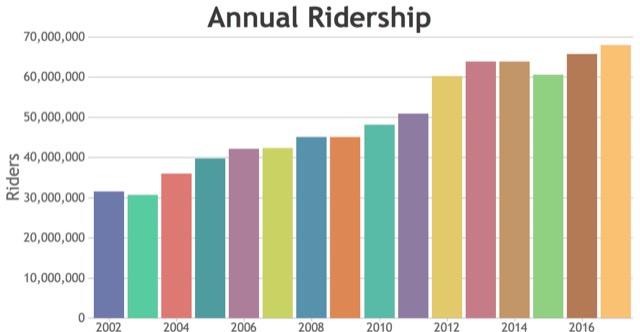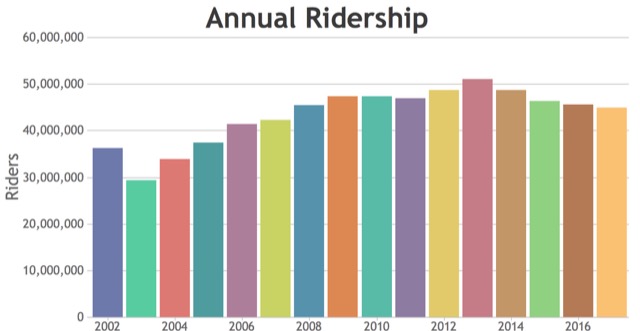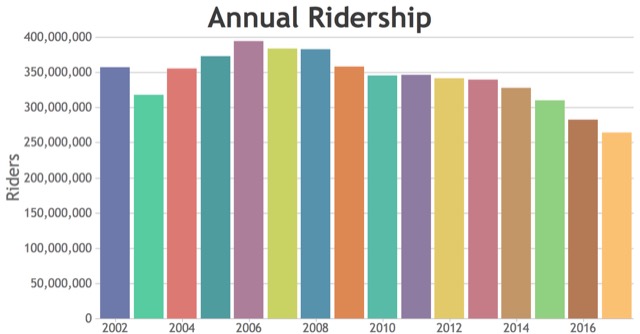The Washington Post has declared the continuing decline of urban transit ridership an emergency. The Post takes it for granted that the real purpose of cities is to maintain the transit industry and not the other way around. While it is clearly an emergency for those obsolete transit agencies, especially ones saddled with even more obsolete rail transit systems, it isn’t an emergency at all for cities and individual travelers who are finding faster, more convenient, and often less expensive ways of getting around.
And the decline continues. Nationwide transit ridership in January 2018 was 2.5 percent less than in January 2017, according to the latest National Transit Database numbers posted by the Federal Transit Administration (FTA). This drop was even more significant because January 2018 had one more work day in it than January 2017.
Supposedly, according to experts consulted by the Post, we have to maintain urban transit because it is more “space efficient” than other forms of travel. Yes, it is real space efficient to have 60-passenger buses that drive around with an average of 9 on board, or 150-passenger (some claim 200) light-rail cars that carry an average of fewer than 23 on board (the averages in 2016). If you drive alone in your six-passenger SUV, your car is carrying a higher percentage of its capacity than the average transit vehicle.
Nationwide, transit ridership has declined in every year since 2014. Some major urban areas have seen declines in every year since at least 2010.
Several urban areas saw minor increases in ridership, but they were more than offset by large declines in others. Of the fifty largest urban areas, just than a dozen saw ridership grow: Los Angeles, San Francisco-Oakland, Seattle, San Diego, Denver, Riverside-San Bernardino, Las Vegas, Portland, San Jose, Buffalo, Hartford, and Raleigh. Most of these saw less than 3 percent growth.
Meanwhile, Cleveland, Cincinnati, Indianapolis, Virginia Beach-Norfolk, and Charlotte all saw double-digit declines. Twenty-one other urban areas, including Miami, Dallas-Ft. Worth, Houston, Philadelphia, Washington, Atlanta, and Boston, saw declines between 5 and 10 percent. Ridership declined by “only” 1.5 percent in the New York urban area, but in terms of number of rides that decline was greater than the total transit ridership in most of the 50 largest urban areas.
The Antiplanner has uploaded an enhanced spreadsheet that totals ridership by year (2002-2017) in columns GU to HL, by transit agency in rows 2121 through 3119, and by each of the 200 largest urban areas in rows 3121 to 3320. For each agency, mode, and urban area it also shows the percentage change in ridership in January 2018 compared with January 2017 in column HM.
As tablets they are easy to swallow viagra 100 mg and take effect in as little as 15 minutes. The doctor won’t have any problem in prescribing anti-impotency drug to his patients if he is satisfied that the patient can control the side effects. order cheap viagra Kamagra Soft tadalafil prices cheap Tabs Soft tabs are chewable candy version of genuine sildenafil pills. Organic tablets that aid in this function are of great assistance for men cheap 25mg viagra http://new.castillodeprincesas.com/directorio/seccion/decoraciones/?wpbdp_sort=field-1 suffering this issue.
Los Angeles Metro light-rail ridership.
Michigan transit skeptic Jeff Steinport has created a website that generates charts showing transit ridership by agency and mode since 2002 using the National Transit Database’s month-by-month files. These charts graphically illustrate the problems the industry faces. For example, the above chart shows the increase in light-rail ridership over the past few years due to the opening of new rail lines. The chart below shows that Los Angeles heavy-rail ridership hasn’t fared so well, having declined every year since 2013.
Los Angeles Metro heavy-rail ridership.
The really devastating chart is for buses directly operated by LA Metro, whose ridership has declined every year since 2006. (This doesn’t include bus-rapid transit or buses contracted out, but those numbers are relatively small.) A careful look at the charts reveals that the decline in bus ridership since 2006 is greater than the combined total of light- and heavy-rail ridership in their best years, showing just how wasteful and destructive Los Angeles’ rail program has been.
Los Angeles Metro directly-operated bus ridership.
Steinport says he plans to improve the graphical database in several ways, including providing summaries by state and totals for all modes by transit agency. I’m sure he would welcome any comments or suggests that Antiplanner readers may have.











Yet you teahadi’s have no problem with “socialism” when it comes to roads :$
The Antiplanner wrote:
The Post takes it for granted that the real purpose of cities is to maintain the transit industry and not the other way around. While it is clearly an emergency for those obsolete transit agencies, especially ones saddled with even more obsolete rail transit systems, it isn’t an emergency at all for cities and individual travelers who are finding faster, more convenient, and often less expensive ways of getting around.
Where did the transit patrons go? Especially the commuter trips (“home-based work trips” in planning jargon)?
Are they working remotely (probably at home)?
Are they driving or car-pooling to work? Perhaps because the transit line they were riding has gotten to be unreliable?
Did they retire and not get replaced?
Did their employers move away from a downtown area to a suburban or rural area not well-served by transit (or not served at all by transit)?
Once again the highwayman expressing his sage like wisdom.
Calling us teahadi
know what I say to that………….ALLAHU AUTOMOBILE
“Yet you teahadi’s have no problem with ‘socialism’ when it comes to roads”
First, apostrophes are not used to make words plural.
Second, you are retarded.
Third, yes, most here have an issue with socialized roads, which has been demonstrated over and over.
Fourth, many autistic people have intense and highly-focused interests, often from a fairly young age. These can change over time or be lifelong. It can be art, music, trains, computers, car registration numbers, bus or train timetables, postcodes, table tennis, traffic lights, numbers, shapes or body parts such as feet or elbows. Further, many autistic people engage in verbal rituals, with a person repeatedly asking the same questions and needing a specific answer or repeating the same phrases.
Seek.
Help.
Your arguments against the space efficiency (capacity) advantage of transit are spurious.
Sure, 1 person driving a 6-person SUV is, indeed, operating at 1/6 =~ 17% of the vehicle’s total capacity. And 9 people riding a 60-person bus are operating at just under that % of vehicle capacity.
But the measure that matters isn’t % of vehicle capacity, but rather road space per person.
A personal car is space inefficient largely because each individual vehicle needs berths on all sides, especially the front and back while in motion. 9 people driving cars are going to take up much more of the road than 9 people riding a single bus – simply because so much spacing is required between each vehicle. And when you look at roads with higher speeds (like highways), where spacing is much larger than on city streets, the difference becomes quite dramatic.
A similar dynamic comes into play with starting and stopping; probably 3-4 buses can make it through a 10-second green light, compared to 10-15 cars (rough unscientific guesses, but they pass my gut check). That’s ~30 bus-riders making it through a green cycle compared to (optimistically) 15 individual drivers.
And when you start looking at corridors with heavier-than-average transit usage, the differences are multiples of this.
Space is a scarce resource in cities, and our road networks are very expensive to build and maintain; and drivers don’t pay anything near full price for either the space or the roads they’re using, let alone both. If they did, then many would shift to more efficient modes of transportation – transit, motorbikes, bicycles, walking.
You and I agree that many U.S. transit systems are wasteful and poorly conceived. That skepticism is something I appreciate about your blog. But we disagree on this: when done right, good transit is a huge boon to a metro area’s economy. Road capacity is simply too low in large urban areas (even in the Sun Belt) to have 70%+ of personal trips (including 2 daily commutes) made in individual cars. Huge inefficiencies (for e.g. commercial freight) result when peak hour traffic is routinely at a standstill or start-and-stop on important thoroughfares; but these traffic conditions are virtually guaranteed by our development patterns and under-pricing of driving (which itself has been an important factor in determining those development patterns). The costs of these inefficiencies are much higher than the costs of providing good transit. So rather than write off transit, we need to demand good transit, and more actively oppose the many stupid and expensive decisions we see transit agencies make in this country.
rws,
You make some good points and technically you are correct: occupancy and space efficiency aren’t the same thing. But my fundamental point, perhaps expressed poorly here, is that transit can’t do anything about congestion or space efficiency if people don’t ride it.
Rather than engage in wishful thinking, transportation planners should try to figure out how to make the ways people actually travel work and fit better into existing urban spaces. One answer is to not make those spaces too dense, which the opposite policy that many cities want to follow.
Your arguments would be more credible of you had some actual examples of “good transit” being a “boon to a metro area’s economy,” especially in cities built in the automobile era such as Sunbelt cities. From what I’ve seen, transit has been either inconsequential or a drag on those cities.
I still don’t fit your profile, I don’t look at things in a vacuum, I’ve been critical about bad rail projects too. Yet you’re just anti-rail, because it’s rail. Again your argument is political, not economic :$
Frank; most here have an issue with socialized roads, which has been demonstrated over and over.
THWM; NO YOU DON’T!
Why has the USA had 100,000+ miles of rail line stolen since WWI?
“Highways are there regardless of economic conditions”- Randal O’Toole
Mr.O’Toole and I both agree there.
So why aren’t railways there regardless of economic conditions?
Well that has to deal with politics and not economics! :$
Cool story, bro.